The Ultimate Arcade Experience - Play the Best Games Today
Our collection of arcade games has something for everyone, from timeless classics to the latest hits. With a carefully curated list of the best games, you're guaranteed to have an unforgettable time. Whether you're a seasoned gamer or a newcomer, you'll find endless hours of fun and excitement with our top-rated arcade games.
| Game | Description | |||
|---|---|---|---|---|
| Arcade | ||||
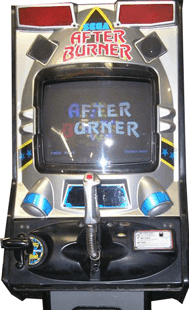 | After Burner Sega (1987) | After Burner is a rail shooter arcade video game developed and released by Sega in 1987. The player controls an American F-14 Tomcat fighter jet and must clear each of the game's eighteen unique stages by destroying incoming enemies. The plane is equipped with a machine gun and a limited supply of heat-seeking missiles. The game uses a third-person perspective, as in Sega's earlier Space Harrier (1985) and Out Run (1986). It runs on the Sega X Board arcade system which is capable of surface and sprite rotation. It is the fourth Sega game to use a hydraulic "taikan" motion simulator arcade cabinet, one that is more elaborate than their earlier "taikan" simulator games.[10] The cabinet simulates an aircraft cockpit, with flight stick controls, a chair with seatbelt, and hydraulic motion technology that moves, tilts, rolls and rotates the cockpit in sync with the on-screen action. Designed by Sega veteran Yu Suzuki and the Sega AM2 division, After Burner was intended as being Sega's first "true blockbuster" video game. Development began in December 1986, shortly after the completion of Out Run, and was kept as a closely guarded secret within the company. Suzuki was inspired by the 1986 films Top Gun and Laputa: Castle in the Sky; he originally planned for the game to have an aesthetic similar to Laputa, but instead went with a Top Gun look to make the game approachable for worldwide audiences. It was designed outside the company in a building named "Studio 128", due to Sega adopting a flextime schedule to allow for games to be worked on outside company headquarters. An updated version with the addition of throttle controls, After Burner II, was released later the same year. | ||
 | Asteroids Atari (1979) | Asteroids is a space-themed multidirectional shooter arcade video game designed by Lyle Rains and Ed Logg released in November 1979 by Atari, Inc. The player controls a single spaceship in an asteroid field which is periodically traversed by flying saucers. The object of the game is to shoot and destroy the asteroids and saucers, while not colliding with either, or being hit by the saucers' counter-fire. The game becomes harder as the number of asteroids increases. | ||
| Big Buck Hunter II Incredible Technologies (2003) | A shooting game where the player uses a pump-action shotgun and hunts deer and elk in various terrains in The United States and Canada. A sequel to the original Big Buck Hunter. | |||
 | Centipede / Millipede / Missle Command / Let's Go Bowling Atari | Centipede/Millipede/Missile Command was produced by Team Play in 2001. Other machines made by Team Play during the time period Centipede/Millipede/Missile Command was produced include Star Trek Voyager, Joust / Robotron, Defender / Defender II, Bopper Ball, Defender / Defender II, and Cow Tipping. A new combo game containing three Atari classics in one. | ||
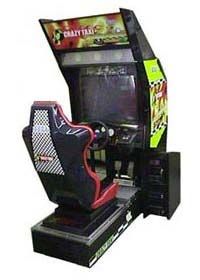 | Crazy Taxi Sega (1999) | Crazy Taxi is a series of racing games developed by Hitmaker and published by Sega. It was first available as an arcade video game in 1999. Each game has the player assume the role of a taxi driver who must accumulate money by delivering passengers to their destinations in the fastest time possible, earning tips by performing "crazy stunts" before the time runs out. The franchise has been recognized for its innovative gameplay design which is easy to learn but difficult to master, its use of in-game advertising, and its soundtrack music provided by the bands The Offspring and Bad Religion. | ||
 | Cruis'n World 1996 (1996) | Cruis'n World is a 1996 racing game developed by Midway Games and published by Nintendo. It is the sequel to the 1994 arcade racer Cruis'n USA. A port for the Nintendo 64 developed by Eurocom was released in 1998, and was the best received of the Cruis'n ports. | ||
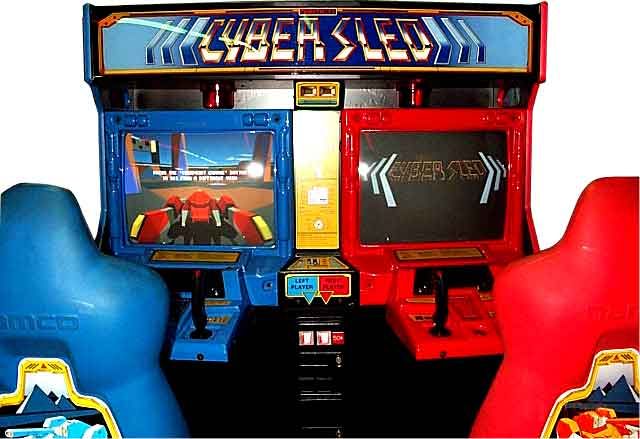 | CyberSled Namco (1993) | Cyber Sled is a vehicular combat video game developed and published by Namco. It was originally released for arcades in 1993. The game's perspective is third-person by default, but can be switched to a first-person perspective. The game was nominated for Most Innovative New Technology at the 1994 AMOA Awards. It later received a sequel in 1994, Cyber Commando. | ||
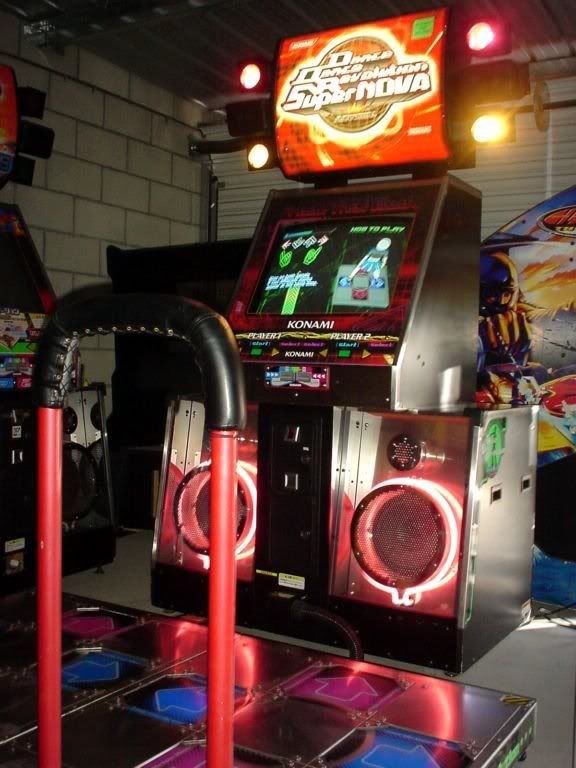 | Dance Dance Revolution Super Nova Konami (2006) | Dance Dance Revolution SuperNova[a], released in Europe as Dancing Stage SuperNova is an arcade and PlayStation 2 game in the Dance Dance Revolution (DDR) series of music video games. It was produced by Konami and released through Betson Enterprises. The game was released in Europe on April 28, 2006, followed shortly by a North American release in May and a Japanese release on July 12. It is the first DDR game released for the arcades since Dance Dance Revolution Extreme three years before, although there had been steady releases of DDR games for consoles in the interim. Instead of Bemani System 573 Digital, the arcade version was built using the PlayStation 2-based Bemani Python 2, which results in higher-quality graphics and superior sounds than previous games. Unlike previous DDR arcade releases, all versions have the same features and song list. It is the fifth arcade release in Europe, the third arcade release in North America, and the ninth arcade release in Japan.[citation nee | ||
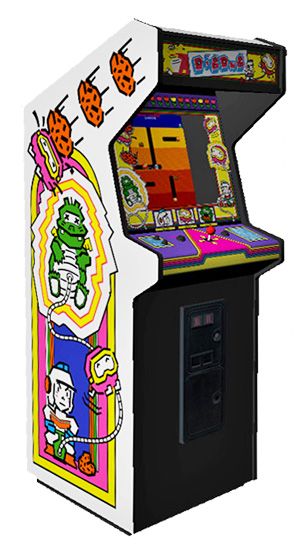 | Dig Dug Namco (1982) | Dig Dug is a maze arcade video game released by Namco in 1982. It was distributed in North America by Atari, Inc. The player digs underground tunnels to attack enemies in each level, by either inflating them to bursting or crushing them underneath rocks. | ||
 | Donkey Kong Nintendo (1981) | Donkey Kong[c] is a 1981 arcade video game developed and published by Nintendo. As Mario, the player runs and jumps on platforms and climbs ladders to ascend a construction site and rescue Pauline from a giant gorilla, Donkey Kong. It is the first game in the Donkey Kong series and Mario's first appearance in a video game. | ||
 | Donkey Kong Jr. Nintendo (1982) | Donkey Kong Jr. is a 1982 arcade platform game that was released by Nintendo. It is the sequel to Donkey Kong, but with the roles reversed compared to its predecessor: Mario (formerly named "Jumpman") is now the villain and Donkey Kong Jr. is trying to save his kidnapped father. It was first released in arcades and, over the course of the decade, was released for a variety of home platforms. | ||
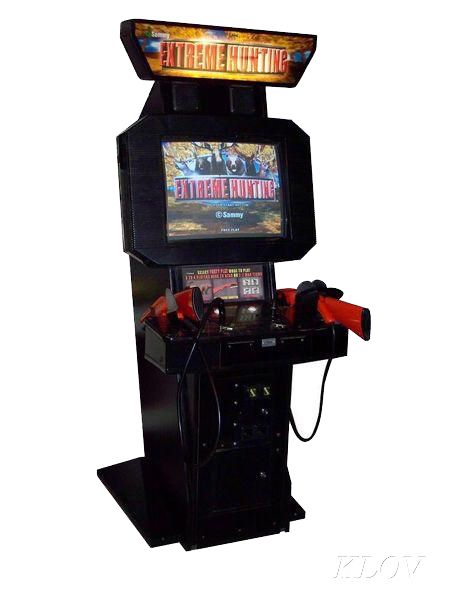 | Extreme Hunting Sammy USA Corporation (2000) | A 3-D hunting game where players use pump-action rifles to shoot on-screen animanls including deer, moose, elks and bears. The game has three selectable weapons: rifle, shotgun and power bow. | ||
 | Final Lap Atari/Namco (1988) | Final Lap is a 1987 racing simulation video game developed and published by Namco. Atari Games published the game in the United States in 1988. It was the first game to run on Namco's then-new System 2 hardware and is a direct successor to Namco's Pole Position (1982) and Pole Position II (1983). Final Lap was the first racing game to allow up to eight players to simultaneously race on the Suzuka Circuit in a Formula One race. This was, at the time, considered a revolutionary feature, and was implemented by linking together up to four two-player sitdown-style arcade cabinets. | ||
 | Frogger Konami (1981) | Frogger is a 1981 arcade action game developed by Konami and published by Sega. In North America, it was distributed by Sega/Gremlin. The object of the game is to direct five frogs to their homes by dodging traffic on a busy road, then crossing a river by jumping on floating logs and alligators. | ||
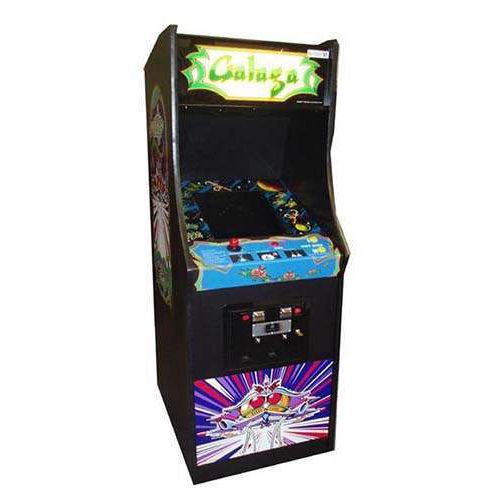 | Galaga Midway (1981) | Galaga is a 1981 fixed shooter arcade video game developed and published by Namco. In North America, it was released by Midway Manufacturing. It is the sequel to Galaxian (1979), Namco's first major video game hit in arcades. Controlling a starship, the player is tasked with destroying the Galaga forces in each stage while avoiding enemies and projectiles. Some enemies can capture a player's ship via a tractor beam, which can be rescued to transform the player into a "dual fighter" with additional firepower. | ||
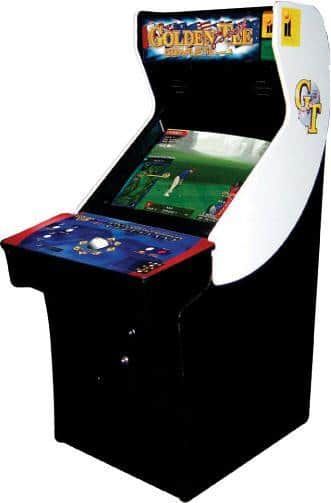 | Golden Tee Incredible Technologies (1989) | Golden Tee is a golf arcade game series by Incredible Technologies. Its signature feature is the use of a trackball to determine the power, direction and curve of the player's golf shot. Play modes include casual 18-hole golf, closest to the pin, and online tournaments. One of the longest running arcade game series, Golden Tee has maintained a large following and spawned a competitive tournament scene. | ||
 | Hang On Sega (1985) | Hang-On is an arcade racing game released by Sega in 1985 and later ported to the Master System. In the game, the player controls a motorcycle against time and other computer-controlled bikes. It was one of the first arcade games to use 16-bit graphics and uses the Super Scaler arcade system board, created with design input from Yu Suzuki, as technology to simulate 3D effects. The deluxe cabinet version also introduced a motion-controlled arcade cabinet, where the player's body movement on a large motorbike-shaped cabinet corresponds with the player character's movements on screen. | ||
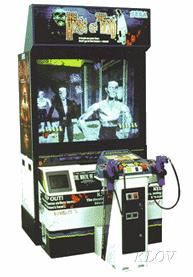 | House of the Dead Seg (1997) | Go through a mansion filled with zombies, chainsaw-wielding undead and other creatures. You must destroy their evil creator, Dr. Curien, while saving scientists and your girlfriend. House Of The Dead, The was produced by Sega in 1997. Sega released 594 machines in our database under this trade name, starting in 1960. Sega is based in Japan. | ||
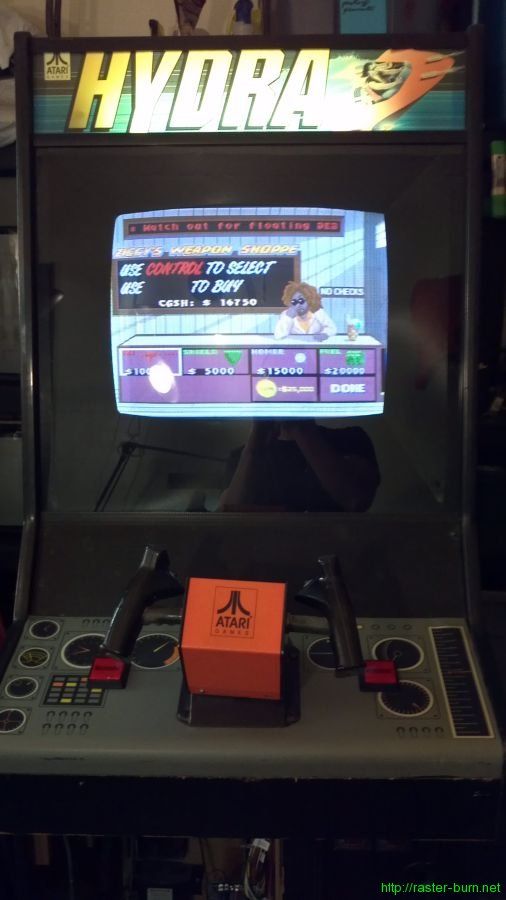 | Hydra Atari (1990) | Hydra is a 1990 arcade vehicular combat video game developed and published by Atari Games. In Hydra, the player pilots a hovercraft, trying to deliver top secret items while avoiding mines, other hovercraft, and logs. The player can collect money and fuel and the game uses X-Y yoke control. In Hydra, thieves are trying to steal the treasures from a museum which contain secrets to a weapon, and it is up to the player to stop them. The player is issued an experimental speedboat to navigate the rivers and retrieve the treasures from checkpoints. There are nine levels of rivers and oceans. While playing the game, the player can collect money bags for extra cash and crystals for extra fuel. The obstacles are gun embankments, enemy crafts and other nuisances that will slow the player down and may cause the cargo to be dropped and float downstream which will need to be retrieved. At the end of each level, the player drops off the cargo and can buy upgrades from a shop to improve the Hydra speedboat. | ||
 | Mortal Kombat Midway (1992) | Mortal Kombat is an American media franchise centered on a series of fighting video games originally developed by Midway Games in 1992. The original Mortal Kombat arcade game spawned a franchise consisting of action-adventure games, a comic book series, a card game, films, an animated TV series, and a live-action tour. Mortal Kombat has become the best-selling fighting game franchise worldwide and one of the highest-grossing media franchises of all time. The series has a reputation for high levels of graphic violence, including, most notably, its fatalities, which are finishing moves that kill defeated opponents instead of knocking them out. Controversies surrounding Mortal Kombat, in part, led to the creation of the Entertainment Software Rating Board (ESRB) video game rating system. Early games in the series were noted for their realistic digitized sprites and an extensive use of palette swapping to create new characters. Following Midway's bankruptcy, the Mortal Kombat development team was acquired by Warner Bros. Entertainment and re-established as NetherRealm Studios. | ||
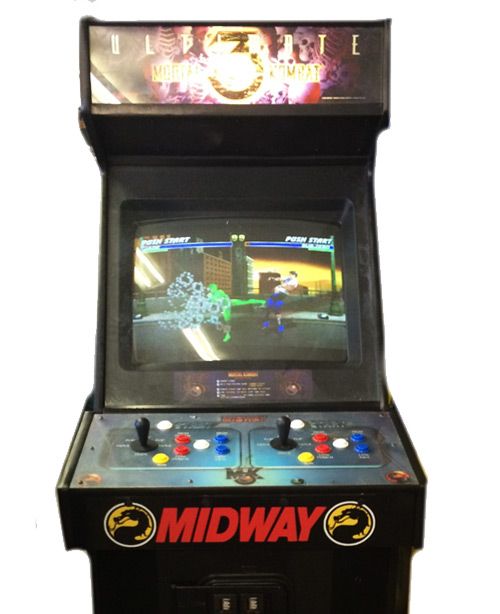 | Mortal Kombat 3 Midway (1995) | Mortal Kombat 3 is a 1995 arcade fighting game developed by Midway Games. It is the third main installment in the Mortal Kombat franchise and a sequel to 1993's Mortal Kombat II. As in the previous games, it has a cast of characters that players choose from and guide through a series of battles against other opponents. The game avoids the tournament storyline of its predecessors, as various warriors instead fight against the returning Shao Kahn, who has resurrected his bride Sindel and started an invasion of Earthrealm. The third installment of Mortal Kombat retains the blood and gory attacks that defined the series. It introduces new types of Fatality finishing moves, including Animalities. Other features new to the series are combos, predefined sequences used to perform a series of consecutive attacks. The new "Run" button allows players to briefly dash toward the opponent, and the new "Kombat Kodes" system allows players to enter various symbols before two-player matches to unlock certain additional features of the game. | ||
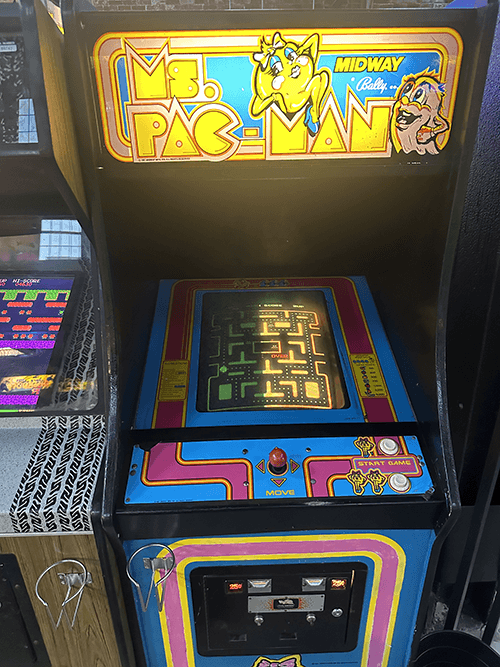 | Ms Pacman Midway (1981) | Ms. Pac-Man is a 1981 maze arcade video game developed by General Computer Corporation and published by Midway. It is a spin-off sequel to Pac-Man (1980) and the first entry in the series to not be made by Namco. Controlling the title character, Pac-Man's wife, the player is tasked with eating all of the pellets in an enclosed maze while avoiding four colored ghosts. Eating the larger "power pellets" lets the player eat the ghosts, which turn blue and flee | ||
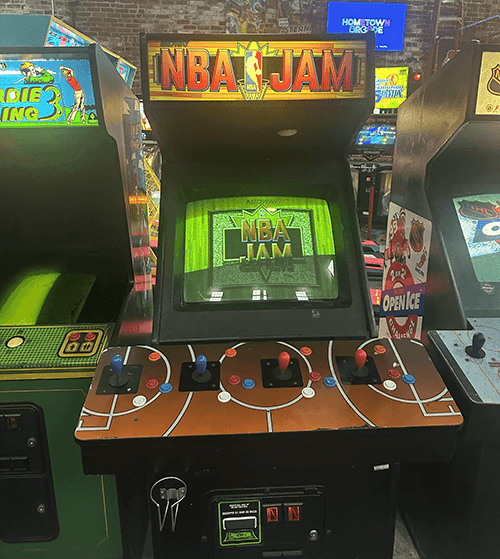 | NBA Jam Midway (1993) | NBA Jam, which features two-on-two basketball, is one of the first real playable basketball arcade games and is also one of the first sports games to feature NBA-licensed teams and players, and their real digitized likenesses. A key feature of NBA Jam is the exaggerated nature of the play – players can jump extremely high and make slam dunks that defy both human capabilities and the laws of physics. | ||
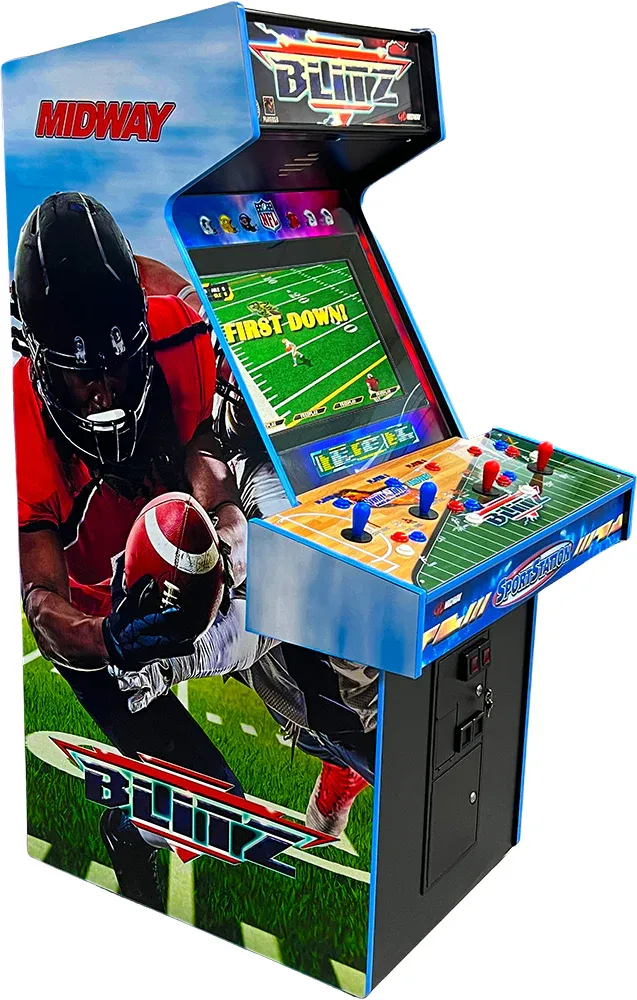 | NFL Blitz Midway (1997) | NFL Blitz is a series of American football themed video games originally released by Midway featuring National Football League (NFL) teams. It began as a 1997 arcade game NFL Blitz that was ported to home consoles and spawned a series of sequels. Rather than being designed as a realistic interpretation of the sport of football, like Madden NFL or NFL 2K, the Blitz series was created as an over-the-top, exaggerated version of the sport, inspired by Midway's own NBA Jam basketball games. | ||
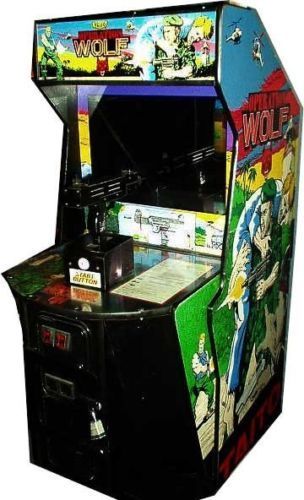 | Operation Wolf Taito (1987) | Operation Wolf is a light gun shooter arcade game developed by Taito and released in 1987. It was ported to many home systems. The game was critically and commercially successful, becoming one of the highest-grossing arcade games of 1988 and winning the Golden Joystick Award for Game of the Year. Operation Wolf popularized military-themed first-person light gun rail shooters and inspired numerous clones, imitators, and others in the genre over the next decade. It spawned four sequels: Operation Thunderbolt (1988), Operation Wolf 3 (1994), Operation Tiger (オペレーションタイガー) (1998), and Operation Wolf Returns: First Mission (2023). | ||
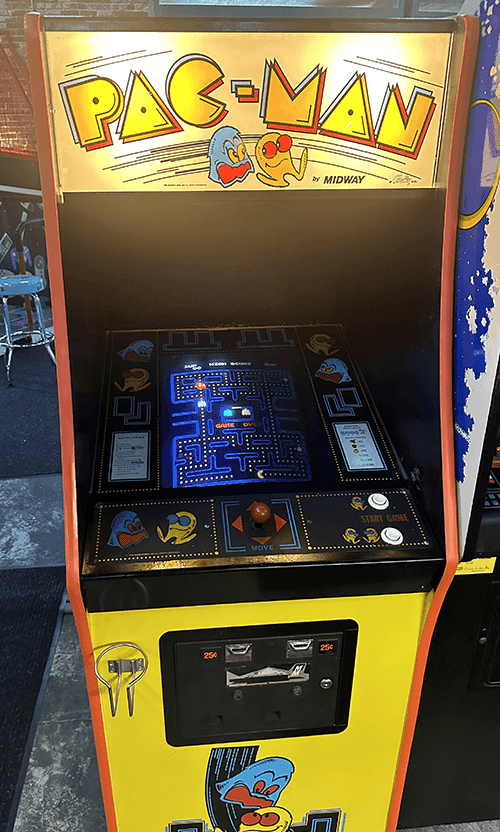 | Pac-Man Namco (1980) | Pac-Man is one of the longest-running, best-selling, and highest-grossing video game franchises in history, and the game has seen regular releases for over 40 years, has sold nearly 48 million copies across all of the platforms, and has grossed over US$14 billion, most of which has been from the original arcade game. The character of Pac-Man is the official mascot of Bandai Namco, and remains one of the most recognizable video game characters in history. The franchise has been seen as important and influential, and is often used as a representation for 1980s popular culture and video games as a whole. | ||
 | Pole Position Namco (1982) | Pole Position is a racing arcade video game released by Namco in 1982. It was licensed to Atari, Inc. for US manufacture and distribution. Pole Position is considered one of the most important titles from the golden age of arcade video games. It was an evolution of Namco's earlier arcade racing electro-mechanical games, notably F-1 (1976), whose designer Sho Osugi worked on Pole Position. The game was a major commercial success in arcades. After becoming the highest-grossing arcade game of 1982 in Japan, it went on to become the most popular coin-operated arcade video game internationally in 1983. In North America, it was the highest-grossing arcade game for both 1983 and 1984 and still one of the top five in 1985. Pole Position spawned ports, sequels, and a Saturday morning cartoon, although the cartoon has little in common with the game. The game established the conventions of the racing game genre and its success inspired numerous imitators. Pole Position is regarded as one of the most influential video games of all time, and is considered to be the most influential racing game in particular. A sequel, Pole Position II, was released in 1983 with four tracks instead of one. | ||
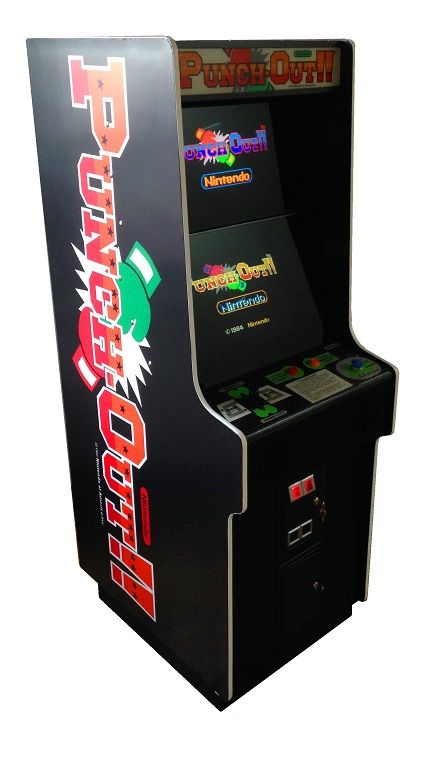 | Punch Out Nintendo (1984) | Punch-Out!![a] is a 1984 arcade boxing video game developed by Nintendo R&D3 and published by Nintendo. It was the inaugural game in the Punch-Out!! series. The original arcade game was a global commercial success, becoming the top-performing arcade game of 1984 in the United States. It produced an arcade sequel known as Super Punch-Out!!, a spinoff of the series titled Arm Wrestling, a highly popular version for the NES originally known as Mike Tyson's Punch Out!!, and Super Punch-Out!! for the SNES. The arcade game introduced recurring characters such as Glass Joe, Bald Bull, and Mr. Sandman. It was also the debut project at Nintendo for composer Koji Kondo, better known for his later contributions to the Super Mario and The Legend of Zelda series. In the game, the player takes the role of a green-haired unnamed boxer (sometimes claimed to be Little Mac from the NES versions[6]), known by three initials the player chooses when the game begins. During matches, the player's boxer is viewed from behind and above as a wireframe so the opponent can be seen. The player must time his punches, dodges and blocks in order to defeat the opposing boxer. Opponents' impending offensive moves are telegraphed by subtle eye changes (the whites of the eyes flash yellow), but the player must ultimately predict what moves the opponent will make and react appropriately. Once the player defeats the last opponent, the opponents repeat with increased difficulty. The player has one 3-minute round to score a knockout and will automatically lose if time runs out. A fighter who is knocked down three times in one round will be unable to rise, leading to a knockout. In the event the player loses, the computer-controlled victor will taunt the player and the corner man for the player will try to entice the player to play again ("Come on, stand up and fight!") via the game's distinctive digitized speech. Players are only allowed one continue per play through. Like many games made during the Golden Age of Arcade Games, there is no actual ending and the game continuously loops until the player loses. The game is a modified upright, and was unusual in that it requires two video monitors, one atop the other, for the game's display. The top monitor is used to display statistics and fighter portraits, while the bottom one is the main game display (similar to Nintendo's Multi-Screen Game & Watch titles and the Nintendo DS) with the gameplay and power meters (representing stamina) for each fighter.[3] Apart from this, the game is more or a less a standard upright. The game has a joystick and three buttons. Two buttons control left and right punches, one for each arm (denoted by "Left!", or "Right!" when hitting the head, or "body blow!" when hitting the body with either arm). A large button on the console allows the player to deliver a powerful uppercut or right hook, but only when the "KO" meter on the display is completely full. The meter increases when the player successfully lands a punch, decreases when the opponent lands one, and drops to zero when the player is knocked down. Once the meter is full, the corner man's digitized speech encourages the player to either "Put him away!" or "Knock him out!" | ||
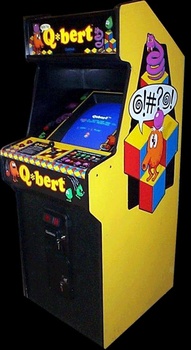 | Q*Bert Gottlieb (1982) | Q*bert is an arcade video game developed and published for the North American market by Gottlieb in 1982. It is a 2D action game with puzzle elements that uses isometric graphics to create a pseudo-3D effect. The objective of each level in the game is to change every cube in a pyramid to a target color by making Q*bert, the on-screen character, hop on top of the cube while avoiding obstacles and enemies. Players use a joystick to control the character | ||
| Revolution X Midway (1994) | Revolution X is a shooting gallery video game developed by Midway and released in arcades in 1994. The gameplay is similar to Midway's earlier Terminator 2: Judgment Day, but is themed around the band Aerosmith. The oppressive New Order Nation regime and their leader Helga have abducted Aerosmith, and players use a mounted gun to control onscreen crosshairs and shoot enemies. The members of Aerosmith are hidden throughout the game's international locales and must be found in order to receive the game's true ending. | |||
 | Robotron 2084 Williams (1982) | The Robotron arcade game is set in the year 2084 in a fictional world where robots (“Robotrons”) have taken control of the world and eradicated most of the human race. The main protagonist is a nameless superhuman attempting to save the last human family. The game uses a two-joystick control scheme; the left joystick controls the on-screen character’s movement, while the right controls the direction the character’s weapon fires. Both joysticks allow for an input direction in one of eight ways. Each level, referred to as a “wave”, is a single screen populated with a large number of various enemy robots and obstacles; types include invincible giants to robots that continually manufacture other robots that shoot the protagonist. Coming into contact with an enemy, projectile, or obstacle costs the player one life, but extra lives can be earned at certain point totals. Waves also include human family members who can be rescued to score additional points, but certain robots can either kill them or turn them into enemies. Destroying all vulnerable robots allows the player to progress to the next wave; the cycle continues until all reserve lives are lost. | ||
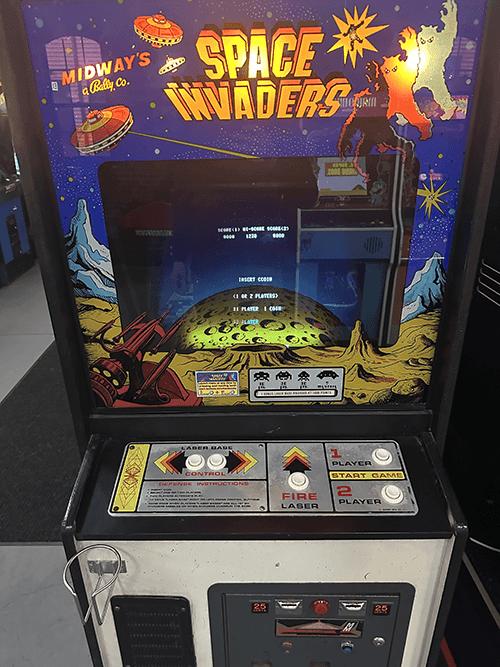 | Space invaders Taito (1978) | Space Invaders is a 1978 shoot 'em up arcade video game developed by Tomohiro Nishikado. It was manufactured and sold by Taito in Japan, and licensed to the Midway division of Bally for overseas distribution. Space Invaders was the first fixed shooter and set the template for the genre. Space Invaders is considered one of the most influential video games of all time. It ushered in the golden age of arcade video games. | ||
 | Street Fighter II: The World Warrior Capcom (1991) | Street Fighter II: The World Warrior is a 1991 fighting game produced by Capcom for arcades, and their fourteenth game to use the CP System arcade system board. It is the second installment in the Street Fighter series and the sequel to 1987's Street Fighter. Street Fighter II vastly improved many of the concepts introduced in the first game, including the use of special command-based moves, a combo system, a six-button configuration, and a wider selection of playable characters, each with a unique fighting style. Designed by Yoshiki Okamoto and Akira Yasuda, who had previously worked on Final Fight, Street Fighter II is regarded as one of the greatest video games of all time and the most important and influential fighting game ever made. Its launch is seen as a revolutionary moment within its genre, credited with popularizing the fighting genre during the 1990s and inspiring other producers to create their own fighting series. Additionally, it prolonged the survival of the declining video-game arcade business market by stimulating business and driving the fighter genre. It prominently features a popular two-player mode that obligates direct, human-to-human competitive play, inspiring grassroots tournament events, culminating in Evolution Championship Series (EVO). Street Fighter II shifted the arcade competitive dynamic from achieving personal-best high scores to head-to-head competition, including large groups. | ||
 | Super Pac-man Midway / Namco (1982) | Super Pac-Man is a 1982 maze chase arcade game developed and published by Namco. It was distributed in North America by Midway, and is Namco's take on a sequel to the original Pac-Man; | ||
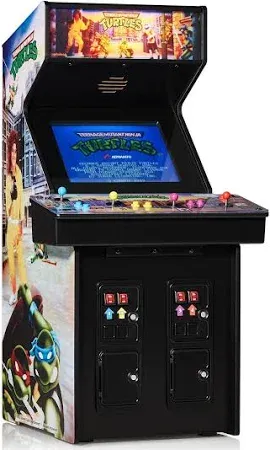 | Teenage Mutant Ninja Turtles Konami (1989) | Teenage Mutant Ninja Turtles, released in Japan as Teenage Mutant Ninja Turtles: Super Kame Ninja and in Europe as Teenage Mutant Hero Turtles, is a 1989 beat 'em up game developed and published by Konami for arcades. It is based on the Teenage Mutant Ninja Turtles franchise, including the first animated series that began airing two years earlier. In the game, up to four players control the titular Ninja Turtles, fighting through various levels to defeat the turtles' enemies, including the Shredder, Krang and the Foot Clan. Released during a high point in popularity for the Teenage Mutant Ninja Turtles franchise, the arcade game was a worldwide hit, becoming the highest-grossing dedicated arcade game of 1990 in the United States and Konami's highest-grossing arcade game. Versions for various home systems soon followed, including the Nintendo Entertainment System. A sequel, Teenage Mutant Ninja Turtles: Turtles in Time, was released in 1991. | ||
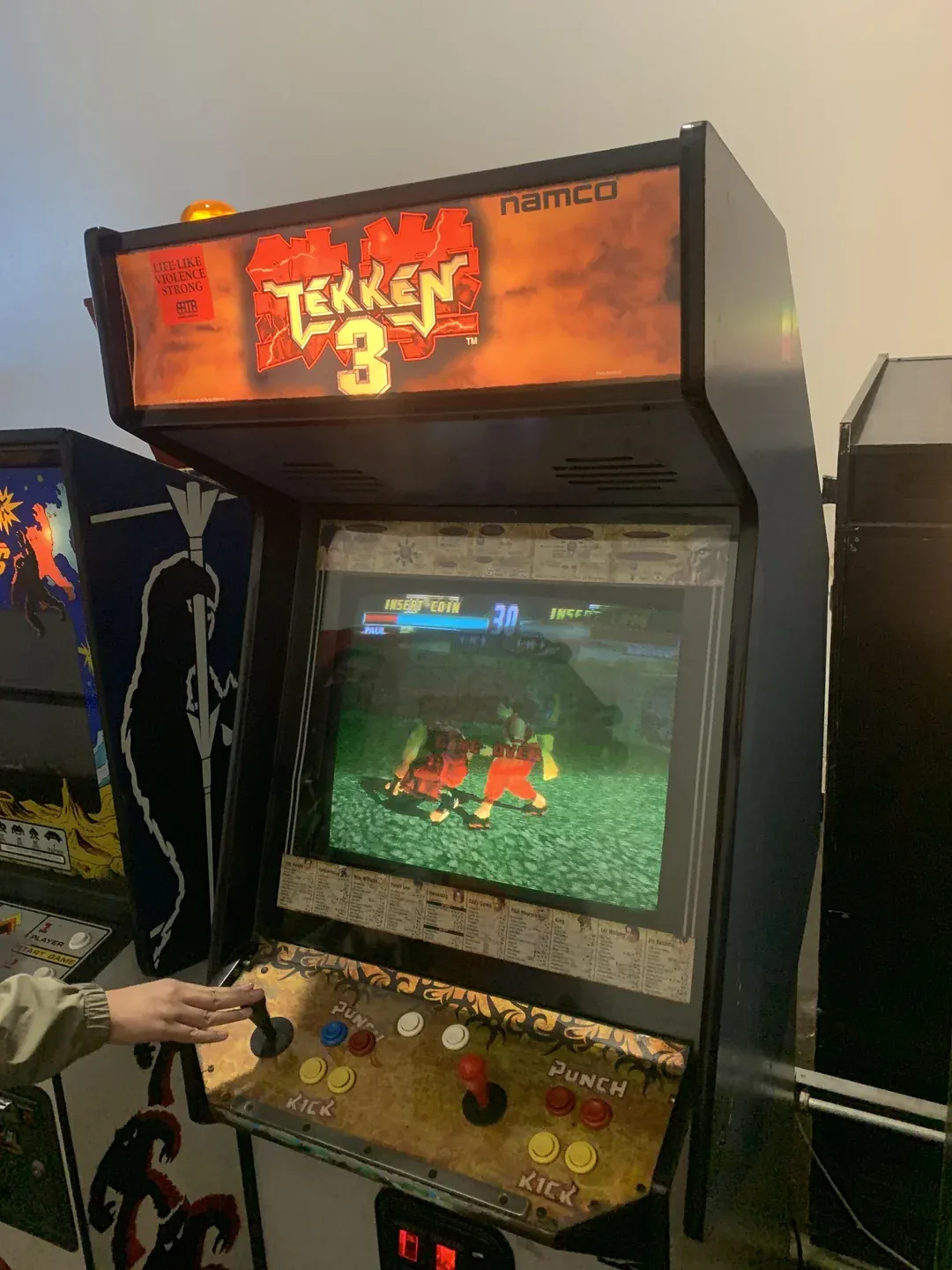 | Tekken 3 Namco (1997) | Tekken 3 (鉄拳3) is a 1997 fighting video game, the third title in Namco's Tekken series, and the first game built on the Namco System 12 arcade hardware. Plot wise, the game takes place twenty years after Tekken 2 (1995) and features a largely new cast of characters, including the debut of several now-staple characters such as Jin Kazama, Ling Xiaoyu and Bryan Fury, and adds sidestepping ability to every character in-game. Tekken 3 was ported to the PlayStation in 1998 with additional content, including a beat 'em up mode called Tekken Force. The game was a major hit for both arcades and consoles, selling 35,000 arcade units and 8.36 million PlayStation copies worldwide, making Tekken 3 the fifth best-selling PlayStation game. Since its release, Tekken 3 has been cited as one of the greatest games of all time. It was followed by Tekken Tag Tournament (1999) and its direct sequel is Tekken 4 (2001). Later, Tekken 3's arcade version was included within Tekken 5 on PlayStation 2, while the console port was re-released as part of Sony's PlayStation Classic. | ||
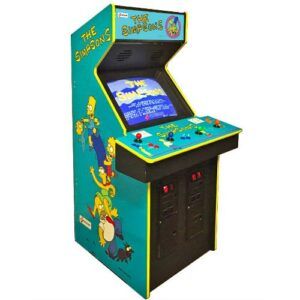 | The Simpsons Konami (1991) | The Simpsons is an arcade beat 'em up developed and published by Konami released in 1991. It was the first video game based on the Simpsons franchise to be released in North America. The game allows up to four players to control members of the Simpson family as they fight various enemies to rescue the kidnapped Maggie. It was a commercial success in the United States, where it was one of the top three best-selling arcade video game machines of 1991, The game also features the television shows's voice actors; Dan Castellaneta, Julie Kavner, Nancy Cartwright and Yeardley Smith reprising their respective roles as the Simpsons family. | ||
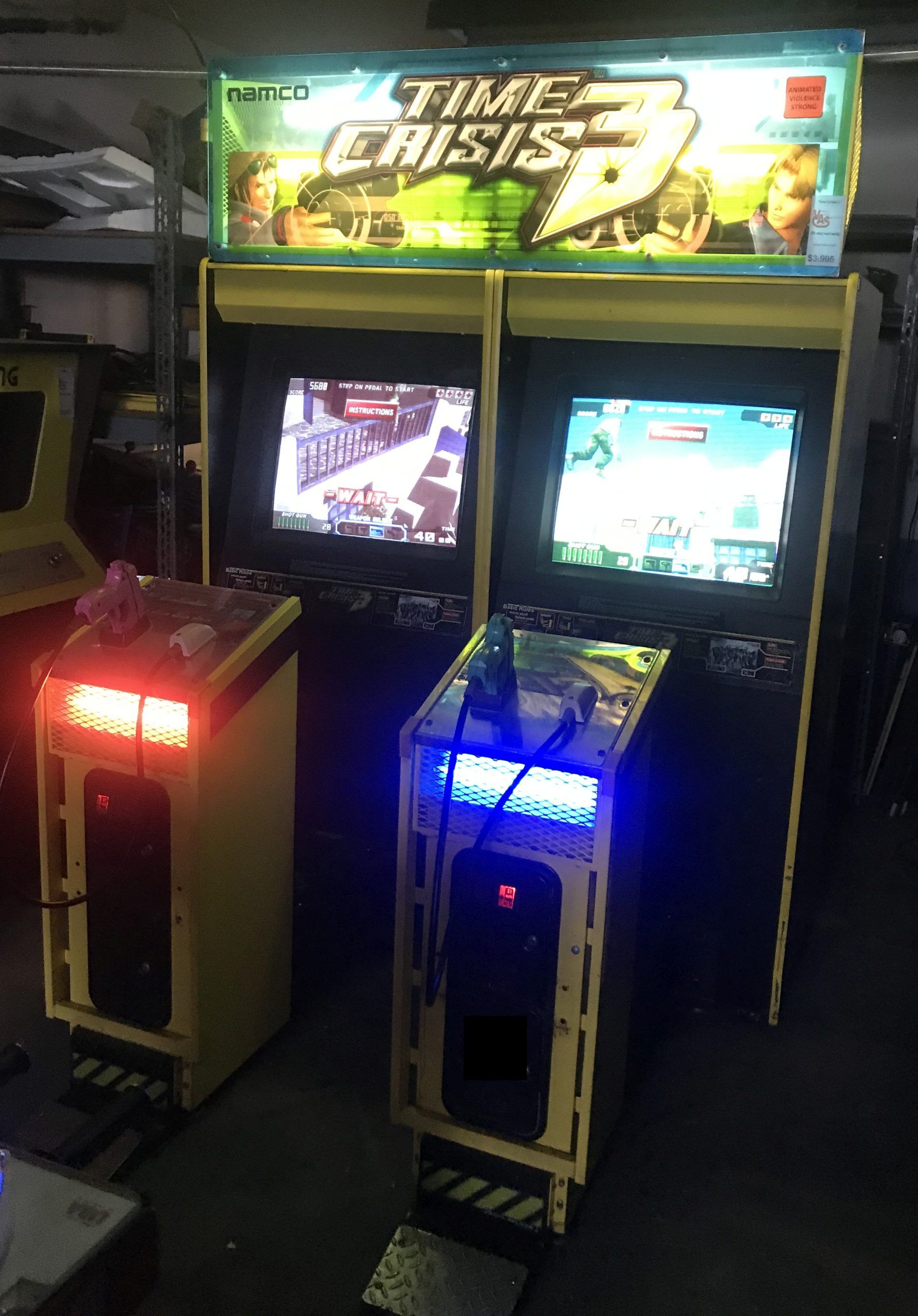 | Time Crisis 3 Namco (2002) | Time Crisis 3 is a rail shooter released for arcades in 2002, and is the third instalment of the Time Crisis series. Like its predecessor, Time Crisis II, it allows for two players to cooperate in a link play environment and has the Time Crisis signature pedal system for hiding and advancing and the first in the series to change or select weapons. | ||
| World Series Sega (1999) | World Series 99, known as Super Major League 99 (スーパーメジャーリーグ99) in Japan, is an arcade baseball game released for Sega NAOMI hardware in 1999. | |||
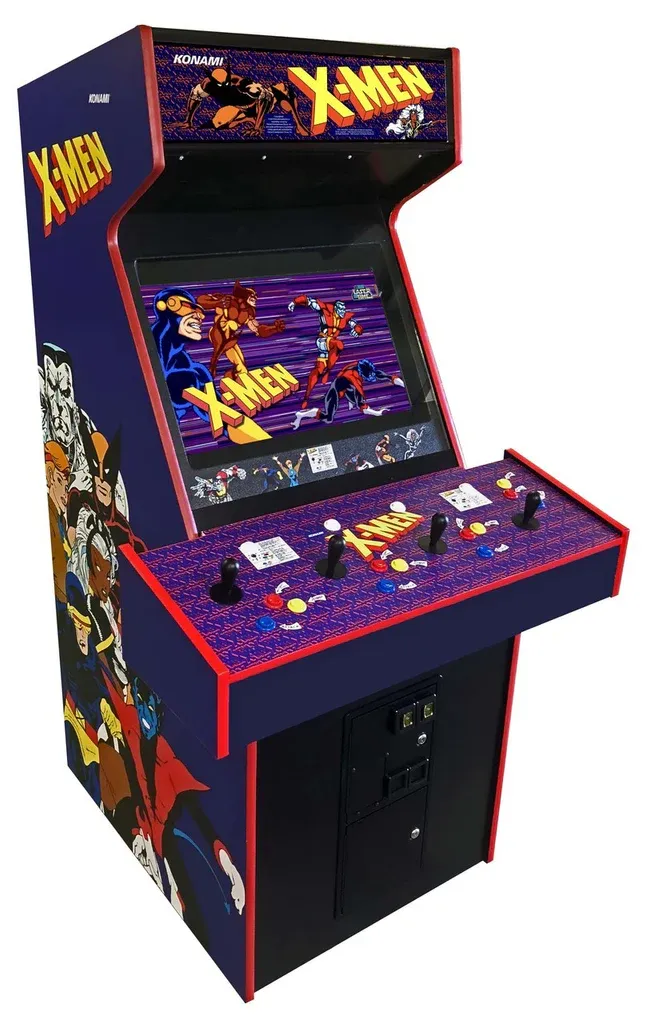 | X-Men Konami (1992) | In X-Men arcade, you select your favorite X-Men character and fight various foes. You can punch, kick, throw, and back-attack the enemies plus jump to avoid or jump-attack the enemies. Each character also has a unique mutant power. Each player can choose to be one of six characters: Cyclops, Colossus, Wolverine, Storm, Nightcrawler, and Dazzler. The bad guys are Pyro, The Blob, The Wendigo, The White Queen, The Juggernaut, Master Mold, three Egyptian statues, Mystique, and Magneto. Each character has different attacks and Mutant Powers consume three units of your energy meter. You receive an extra unit when a level has been completed. | ||
 | Xybots Atari (1987) | Xybots is a 1987 third-person shooter arcade game by Atari Games. In Xybots, up to two players control "Major Rock Hardy" and "Captain Ace Gunn", who must travel through a 3D maze and fight against a series of robots known as the Xybots whose mission is to destroy all mankind. The game features a split screen display showing the gameplay on the bottom half of the screen and information on player status and the current level on the top half. Designed by Ed Logg, it was originally conceived as a sequel to his previous title, Gauntlet. The game was well received, with reviewers lauding the game's various features, particularly the cooperative multiplayer aspect. Despite this, it was met with limited financial success, which has been attributed to its unique control scheme that involves rotating the joystick to turn the player character. | ||
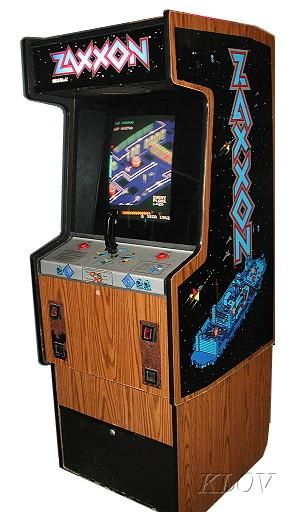 | Zaxxon Sega (1982) | Zaxxon is a scrolling shooter developed and released by Sega as an arcade video game in 1982. The player pilots a ship through heavily defended space fortresses. Japanese electronics company Ikegami Tsushinki was also involved in the game's development. Zaxxon was the first game to employ axonometric projection, which lent its name to the game (AXXON from AXONometric projection). The type of axonometric projection is isometric projection: this effect simulates three dimensions from a third-person viewpoint. It was also the first arcade game to be advertised on television, with a commercial produced by Paramount Pictures for $150,000. The game was a critical and commercial success upon release, becoming one of the top five highest-grossing arcade games of 1982 in the United States. | ||
| Pinball | ||||
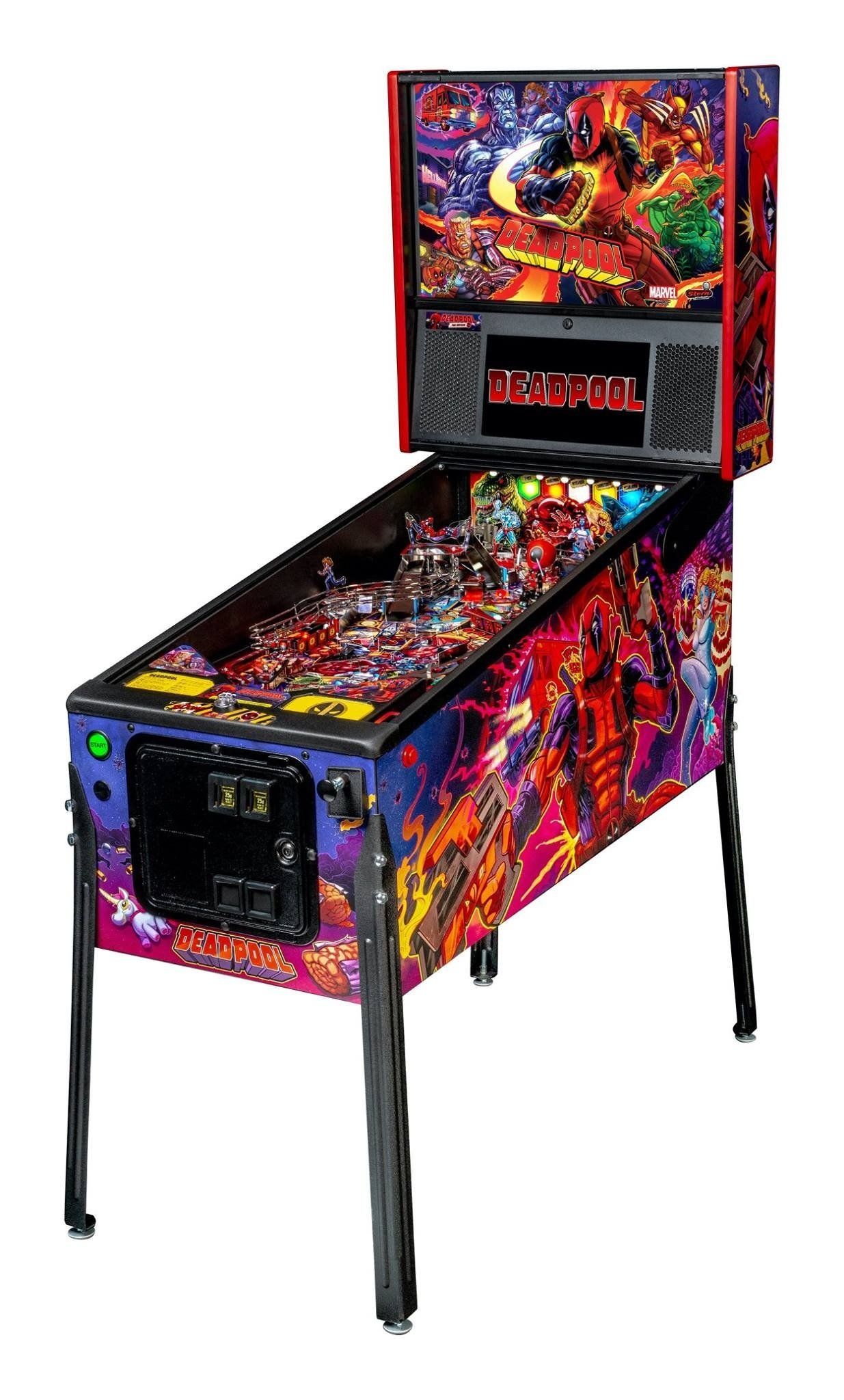 | Deadpool Pinball Stern Pinball (2018) | “Deadpool” is known as the “Merc with a Mouth” because of his talkative nature & is notorious for his outrageously funny offbeat humor which is featured throughout the game. Players will be immersed in the Deadpool universe, teaming up with iconic X-Men characters Wolverine, Dazzler, Domino, and Colossus as they battle against infamous villains Juggernaut, Sabretooth, Mystique, Sauron, and Mr. Sinister. Players will also tag along with Deadpool on his time machine quests as he battles against the T-Rex and the Megalodon. Stern’s Deadpool Pro, Premium, and Limited Edition models feature stunning and distinctive hand-drawn art by renowned illustrator Zombie Yeti. Well known actor Nolan North stars as the eccentric voice of Deadpool. Each game features a 3-bank drop target with a ball lock that’s guarding a custom molded Lil’ Deadpool bash toy target. In addition, all models include two stainless steel and wireform ramps with a Katana Sword ramp return. Deadpool pinball entertains with an amazing array of ninjas, vampires, and chimichangas, making it suitable for all skill levels. | ||
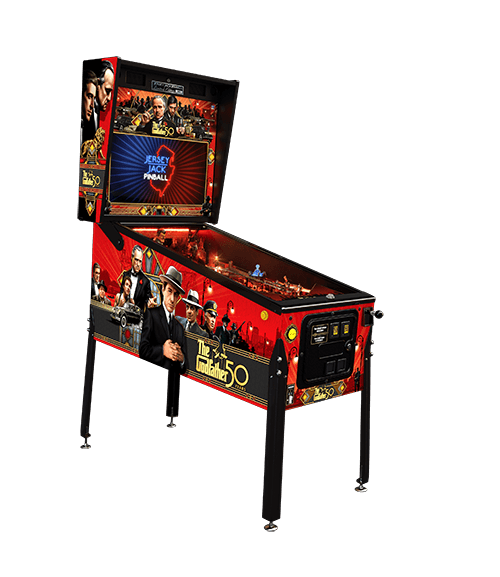 | Godfather Pinball Jersey Jack Pinball (2023) | Step into the captivating world of The Godfather with this recently released pinball marvel from Jersey Jack. Packed with an array of toys, lights, and endless fun, this machine promises an immersive gaming experience like no other. Crafted with meticulous attention to detail, the Godfather Limited Edition features: Metallic Black Armor & Legs for a sleek, stylish look. The iconic Furious Floyd Caporegime head, a striking centerpiece. High-quality gloss decals for a polished finish. Michael Corleone central Playfield image, adding to the ambiance. Individually Numbered Limited Edition Plaque, ensuring exclusivity. Limited to just 5,000 units worldwide. Prepare to be enthralled as you embark on a journey through the Five Families. Control territories, recruit soldiers, and outmaneuver your enemies in this epic battle for dominance. | ||
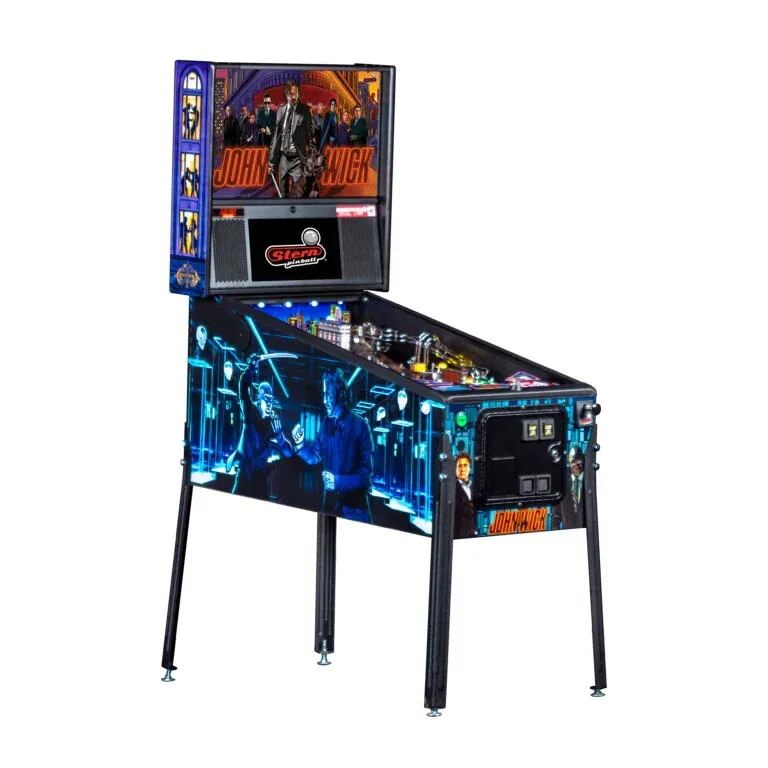 | John Wick Pro Pinball Stern Pinball (2024) | John Wick pinball introduces Stern’s all-new dynamic AI combat system, an innovation that brings the frenetic combat of the legendary films to the game. The Stern team has created a primitive video game AI system to control the enemy lights on the playfield, setting the John Wick pinball games apart from prior pinball machines, where all lights were controlled by player actions, timers, and random number generations. In this new AI combat system, enemy icons are responsive to player behavior and will illuminate dynamically around the playfield to challenge the player. The enemies move tactically with this dynamic software to counter player objectives, creating a unique challenge in each game session. The system also features a new action video player that dynamically reflects player action – as you defeat three enemies, you’ll see video clips of John Wick doing the same in the films! Accompanying the high-quality film and audio assets woven into the gameplay, John Wick pinball games will include custom narration by critically acclaimed actor Ian McShane as Winston and an original score composed by Charlie Benante of Anthrax and Pantera fame. Additionally, pieces of John Wick’s iconic suits used in connection with the production of the films will be included as a franchise artifact in the LE models, courtesy of Lionsgate. The John Wick pinball games will feature original neo-noir style paintings illustrated by acclaimed artist, Randy Martinez. | ||
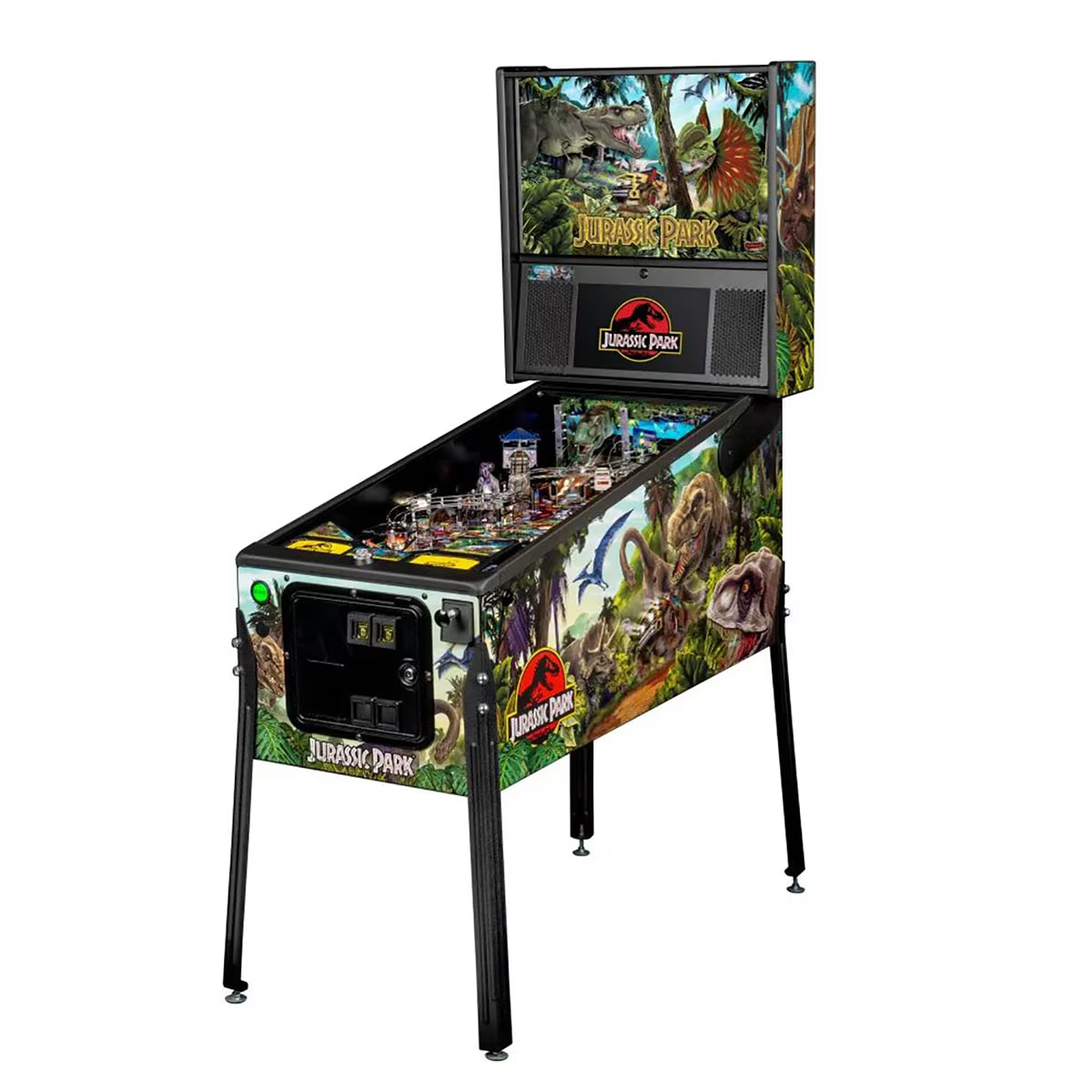 | Jurassic Park Pro Pinball Stern (2019) | With a new original playfield design by award-winning designer Keith Elwin (Iron Maiden) and stunning artwork by Jonathan Bergeron, AKA Johnny Crap (Blink182, Anthrax, Guns N’ Roses), everything from the half-pipe shooter ramp to the incredible playfield and cabinet art is fresh and exciting! The playfield features a brand new simple yet fun mechanical toy Jungle Explorer Vehicle which spins when its Newton-ball is hit, a great feature that ties into the game’s ruleset. The aforementioned shooter lane half pipe steel and wire ramp gets the prehistoric-action-packed game going as soon as you release the plunger by dropping the ball into the right lane and into the bottom flippers. All models feature 4 multiball modes, a 3rd flipper for even more action, a right spiral steel and wire ramp that feeds the upper 3rd flipper, a Spitter Spinning Target and the unforgettable musical score composed by John Williams. | ||
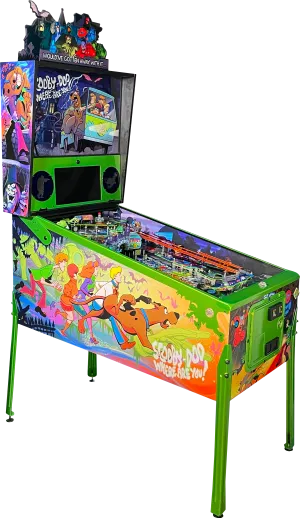 | Scooby-Doo Pinball Spooky Pinball (2022) | Scooby-Doo by Spooky Pinball is a nostalgic and exciting addition to any pinball collection. This widebody pinball machine is based on the classic cartoon "Scooby-Doo: Where are You?". The game features original clips from the show music from Matt “Count D” Montgomery and custom speech from talented voice actors: Frank Welker Matthew Lillard Kate Micucci Grey Griffin and Scott Innes. Players will be drawn into the world of Mystery Inc. Whether you're a fan of the classic cartoon or just love pinball Scooby-Doo is sure to deliver an unmasking pinball experience. | ||
| Stranger Things Pro Stern Pinball (2019) | Experience the terrifying forces in Hawkins, Indiana that turn this small town “upside down” with supernatural elements, strange sightings, and government secrets. Stranger Things pinball machines will immerse players in a search to unravel the extraordinary mysteries and secret government experiments taking place at the Hawkins National Laboratory. The gameplay focuses on unlocking the hidden meanings of supernatural events occurring in and around the town, including the appearance of a girl known as “Eleven” with telekinetic abilities. The ball is wild as Mike, Lucas, Dustin, Will, Joyce, and Police Chief Jim Hopper help Eleven close the dimensional gate. “Stranger Things is one of the most successful shows of all time, connecting with people around the world and across generations. This game features action, mystery, suspense, and humor; Stranger Things is a perfect fit for pinball,” said Gary Stern, Chairman and CEO of Stern Pinball, Inc. | |||
| Sport Game | ||||
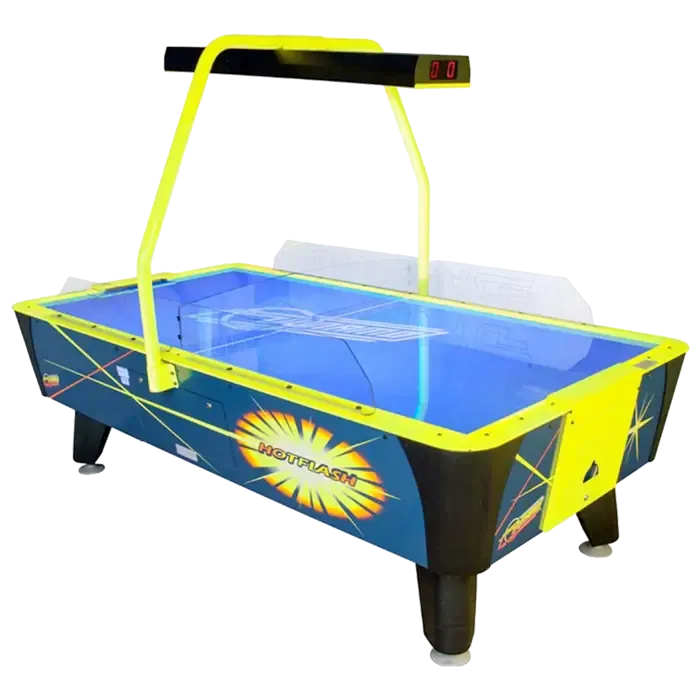 | Air Hockey Dynamo | |||
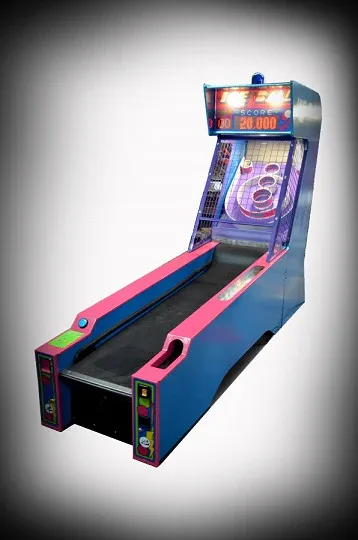 | Ice Ball (3 Lanes) ICE | ICE'S revolutionary version of the traditional alley roller. ICEBALL was designed with the operator in mind at all times. ICEBALL was designed with unprecedented durability and serviceability in every area of the game. It is a 10 ft. alley that has a remarkable number of great features ranging from the electronics which were strategically placed in the front of the game as opposed to the old skeeballs which had all the electronics in the back of the game making access so much more difficult. | ||
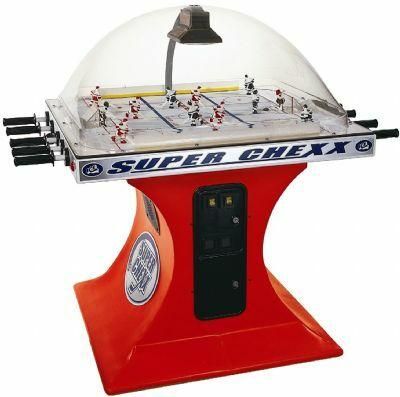 | Super Chexx Bubble Hockey ICE (1999) | ICE's very first coin operated amusement Arcade Game that to this day is still considered one of the ALL TIME CLASSICS!!! Also known as Bubble Hockey, Rod Hockey, and Stick Hockey because of the very distinguished, indestructible dome that covers the playfield. The gameplay is fast, exciting, and realistic as the players on either side control all 5 hockey players and the goalie. The game can be played as a one on one game, or in many cases, especially for tournaments, it is played two on two. The games new electronics record GOALS, SHOTS ON GOAL, PERIOD, and RUNNING TIME. The running time is operator adjustable. There is an automatic puck return system, overhead dome lighting, and if a game is tied after the normal game play it will automatically go into sudden death overtime - so there's always a winner! | ||
The Ultimate Arcade Experience - Play the Best Games Today
Our collection of arcade games has something for everyone, from timeless classics to the latest hits. With a carefully curated list of the best games, you're guaranteed to have an unforgettable time. Whether you're a seasoned gamer or a newcomer, you'll find endless hours of fun and excitement with our top-rated arcade games.

After Burner
Sega - 1987

Asteroids
Atari - 1979
Big Buck Hunter II
Incredible Technologies - 2003

Centipede / Millipede / Missle Command / Let's Go Bowling
Atari

Crazy Taxi
Sega - 1999

Cruis'n World
1996 - 1996

CyberSled
Namco - 1993

Dance Dance Revolution Super Nova
Konami - 2006

Dig Dug
Namco - 1982

Donkey Kong
Nintendo - 1981

Donkey Kong Jr.
Nintendo - 1982

Extreme Hunting
Sammy USA Corporation - 2000

Final Lap
Atari/Namco - 1988

Frogger
Konami - 1981

Galaga
Midway - 1981

Golden Tee
Incredible Technologies - 1989

Hang On
Sega - 1985

House of the Dead
Seg - 1997

Hydra
Atari - 1990

Mortal Kombat
Midway - 1992

Mortal Kombat 3
Midway - 1995

Ms Pacman
Midway - 1981

NBA Jam
Midway - 1993

NFL Blitz
Midway - 1997

Operation Wolf
Taito - 1987

Pac-Man
Namco - 1980

Pole Position
Namco - 1982

Punch Out
Nintendo - 1984

Q*Bert
Gottlieb - 1982
Revolution X
Midway - 1994

Robotron 2084
Williams - 1982

Space invaders
Taito - 1978

Street Fighter II: The World Warrior
Capcom - 1991

Super Pac-man
Midway / Namco - 1982

Teenage Mutant Ninja Turtles
Konami - 1989

Tekken 3
Namco - 1997

The Simpsons
Konami - 1991

Time Crisis 3
Namco - 2002
World Series
Sega - 1999

X-Men
Konami - 1992

Xybots
Atari - 1987

Zaxxon
Sega - 1982

Deadpool Pinball
Stern Pinball - 2018

Godfather Pinball
Jersey Jack Pinball - 2023

John Wick Pro Pinball
Stern Pinball - 2024

Jurassic Park Pro Pinball
Stern - 2019

Scooby-Doo Pinball
Spooky Pinball - 2022
Stranger Things Pro
Stern Pinball - 2019

Air Hockey
Dynamo

Ice Ball (3 Lanes)
ICE

Super Chexx Bubble Hockey